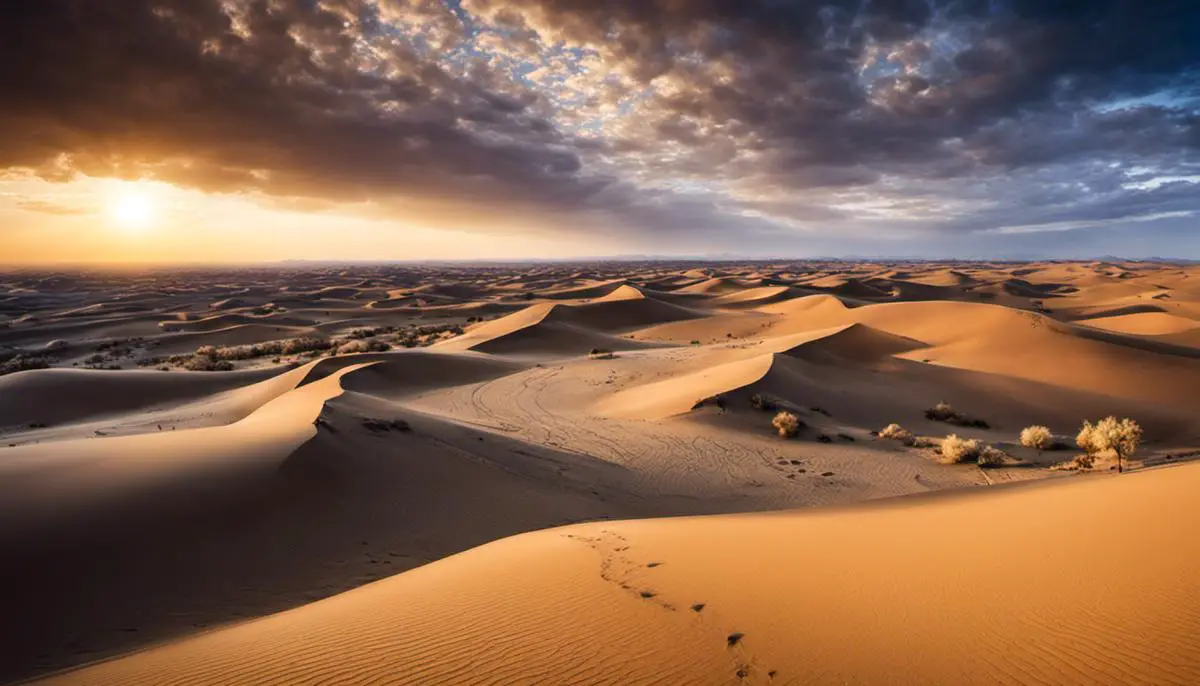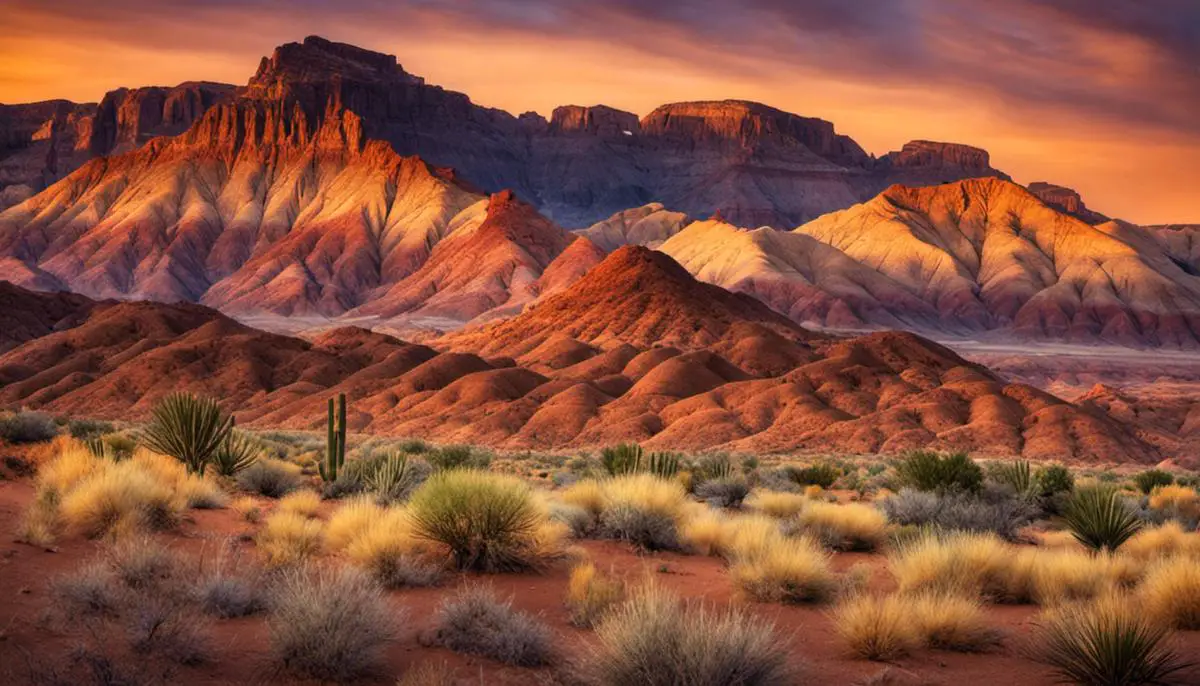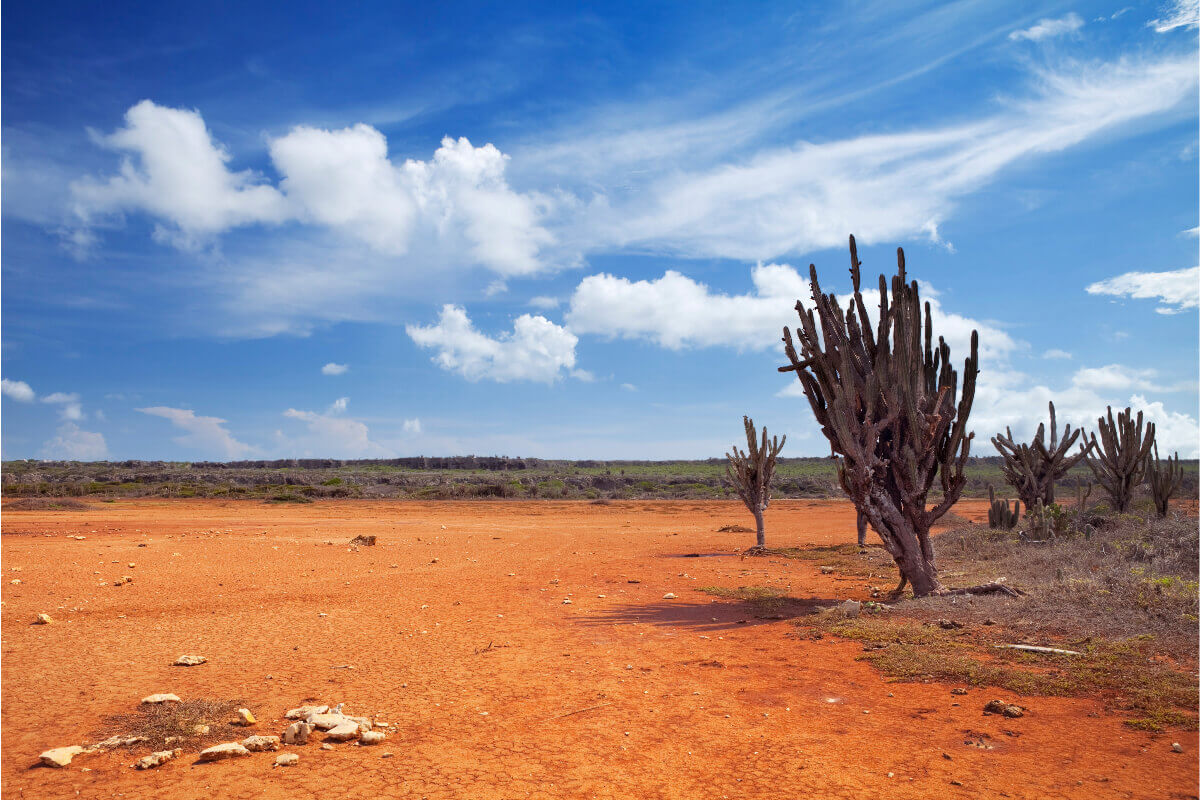Imagine swaths of land bathed in a sun that never seems to dim, armed with a silence so prolific it sings. This is the reality of North America’s deserts – the Mojave, Sonoran, Chihuahuan, and the Great Basin.
From their unique geographical features and distinct flora and fauna to the cultural imprint of indigenous tribes and settlers that have left their mark, an encompassing tale reverberates across these arid terrains. As we delve into an adventure across these deserts, let us remember this journey is not just about the physical landscape but also the rich human history and potential for exploration that dwells within.
Table of Contents
- Distinct features of North American Deserts
- Cultural History and Human Impact
- Exploring Desert Destinations
- Survival Tips and Practical Advice
- Related Questions
Distinct features of North American Deserts
Skip the glitz and glamour of bustling city destinations and immerse in the mystic charm of North America’s pristine deserts! With an uncanny allure that mesmerizes intrepid travelers, the deserts here are ambassadors of Nature’s desolate beauty and hold a singular allure.
They serve as untamed playgrounds for the restless souls, always looking for the next unique experience. Think sweeping dunes, mountains kissed by the dawn, and stars that seem to wink back at you in the profound silence of the night.
One cannot help but command admiration for the resilience and splendor of these unique ecosystems. Every desert in North America speaks volumes about life’s triumph over daunting adversity. Stepping into iconic arid places like the Joshua Tree, Death Valley, or the Sonoran Desert, an overwhelming sense of Nature confronts its fragility with profound resilience.
Cacti raising their prickly arms toward unforgiving sunshine, gusty winds forming mounds of shifting sand, and the whisper of rare desert springs are everyday occurrences in desert life. This remarkable adaptation of flora and fauna to the harsh desert conditions adds another layer of intrigue and allure to these arid landscapes.
Now, who can miss out on mentioning the fantastical geological features? Be awed by the unparalleled formations in Antelope Canyon, or take a moment to admire the spectral colors of Painted Desert at Sunset. These make North American deserts the grand stages of Nature’s most dramatic performances.
What’s more, each desert has an undeniably rich cultural backstory. These barren expanses have cradled ancient civilizations, seen the ebb and flow of history, and nurtured rich indigenous cultures that still flourish amidst the sands. For instance, the Navajo Nation in Arizona offers enlightening experiences about Native American cultures.
In the same vein, these deserts captivate star gazers’ hearts. As darkness descends, the absence of light pollution serves as an invitation to an extraordinary celestial spectacle. The International Dark-Sky Association has declared several parks in the North American desert as Dark Sky Parks, with Death Valley and Joshua Tree among the best!
Desert adventures promise unparalleled opportunities for thrill-seekers. The dunes turn into exhilarating playgrounds for sandboarding and ATV riding. Hiking and rock-climbing aficionados find their adrenaline fix in Moab’s red rocks, Joshua Tree’s stark landscapes, or Sonoran Desert’s challenging terrain.
Rooted in resilience, etched by history, and awash with adventure—North American deserts are time capsules. They stand as a testament to the ceaseless spirit of life that refuses the blanket of desolation.
These are landscapes and destinations for introspection, contemplating life’s infinite mysteries and marveling at the toil of existence against the odds. So, lose those shackles of city life and step onto the sands of time — pun intended; to uncover a world that’s genuinely unlike anything else.

Cultural History and Human Impact
Heading into the scorched heart of North America’s arid expanses, where sandpaintings come alive as intricate narratives of survival, adaptation, and synthesis, we’re offered untold insights into vast, timeless deserts shaped by culture and carving culture in their image.
Today, we dig deeper, unearthing the enthralling dialectic between human civilizations and these seemingly inhospitable terrains.
Envision those Pueblos, Navajo, or Apache tribes that have called these barren expanses home for millennia. Settling in the barren Southwest, they developed sophisticated irrigation systems economizing on every precious drop.
They sprouted corn, beans, and squash, staple crops that nourished and ensured survival. From this, we unravel an unwritten guide in desert living: Embrace scarcity not as an encumbrance but as a catalyst to innovative solutions.
As we delve further, the desert unveils a stunning tapestry of life and culture painted by color-striated rocks. The famed petroglyphs and rock art of the Colorado Plateau stand testament. Echoing stories of human resilience in a challenging environment, they position North American deserts as canvases bearing residues of long-lost civilizations, etching enduring impressions onto their spirit.
Mexico’s Sonoran Desert reels us through time toward contemporary realities. Flanking the US border, we find vibrant artisanal practices shaped by scarcity and creativity. Using local, eco-friendly materials like saguaro cactus skeletons and agave fibers, they craft remarkable multi-generational handicrafts, turning environmental adversity into unique artistry.
Venturing north, we land on Nevada’s Black Rock Desert, a flat alkaline, hosting Burning Man. It’s a temporary city manifesting a countercultural ethos, embodying a ‘leave no trace’ ethos. Its currency? Barter and heartfelt gifting. Its allure? Radical self-expression and community spirit. Borrowing the desert’s impermanence, they erected and razed an entire city yearly. Here, love for the lonely unites thousands, sowing seeds of an alternative communal life.
Finally, human cultures haven’t just survived these deserts—they’ve enhanced them. Consider the desert homes of the Southwest—adobe architecture that’s weather-resistant and environmentally sustainable. Their flat roofs, earth-covered walls, and large porches synergize with the desert to reduce heating and cooling needs and support sustainable living with elegant simplicity.
The human-desert duality unraveled shows us that these aren’t lifeless, forsaken lands but cradles of communities daring the odds and thriving. Beyond survival, they reveal elements of beautifully evolving cultures, resonating a harmonious echo – ingenuity in adversity, wisdom in scarcity, culture in desolateness.
Indeed, North America’s deserts are a mammoth showcase of humanity’s ingenuity in harmonizing with Nature’s odds, a whirling sandstorm of stories ready to unfurl with the next gust of wind. Explore them, and let your own story unfold!

Exploring Desert Destinations
With an in-depth immersion into the appeal of North America’s majestic deserts, let’s now delve deeper to uncover specific destinations brimming with undeniable charm, history, and unique encounters.
Death Valley National Park in California best represents the desert’s stark but captivating allure. As one of the hottest places on earth, its dry, scorched terrain exudes a peculiar beauty that entices wanderers from around the globe. From its colorful badlands to ancient, dried-up salt flats, Death Valley offers the opportunity to experience the raw essence of desert landscapes remarkably.
In New Mexico, White Sands National Park is a must-visit. Its brilliant gypsum dunes, as snow-like carpets stretching to the horizon, provide captivatingly scenic views. Every year, its surreal landscape draws avid photographers, filmmakers, and artists attempting to capture this ethereal beauty. There’s also an opportunity to uncover the stories of early inhabitants with ancient tracks preserved in these dunes, dubbing it a must-see for history buffs.
Moving forward, when talking about a wild yet riveting confluence of histories, landscapes, and cultures – no desert destination pulls it off quite like the Great Basin Desert. Encompassing much of Nevada, this high desert region serves as a quiet sanctuary away from city hustle, offering solitude seekers a chance to experience a potent dose of quiet introspection. It houses the renowned Loneliest Road in America and the ancient Bristlecone Pines, some of the world’s oldest living trees.
Further down into the Southwest, the Sonoran Desert draws visitors with its incredible flora and fauna. The Desert Botanical Garden showcases how lush and diverse a desert ecosystem can be, with clusters of cacti and wildflowers blooming in vibrant colors during spring.
Lastly, the Paiute Indian Tribe of Utah presents a unique opportunity to delve into the rich tapestry of Indigenous cultures. Explore their heritage through music, art, dance, and unforgettable powwow gatherings.
Indeed, there’s more than meets the eye in North America’s deserts. From California’s Death Valley to the tribal regions of Utah, these are locales that do not merely survive amid harsh conditions but thrive, reflecting the resilience and ingenuity of both Nature and humankind.
They are–without a doubt–more than just vast stretches of sand and cacti but living testaments to endurance, history, and the relentless will to flourish amidst adversity. Each corner awaits your footprints, inviting you to learn, engage, reflect, and savor life’s bare, pure savagery.

Survival Tips and Practical Advice
The Expansive and Exotic: Unearthing the Myths and Magic of North America’s Deserts
Sure, deserts may conjure up visions of vast, barren spaces, but there’s much more to it than that. With just a bit more know-how, exploring the desertous landscapes can become a rich and exhilarating experience. So gear up, adventurers, and prepare to uncover the magic of deserts, untethered and unconfined.
Embracing the essential is essential. The desert environment may seem harsh and unrelenting, but as with any venture, it’s about perseverance and preparation, a dash of courage, and a sprinkle of adventurous spirit. Water is your ultimate lifeline, with each person needing at least one gallon daily.
A brimmed hat, sunscreen, and loose, lightweight clothing form the desert explorer’s uniform, protecting against the intense desert sun. A compass or a reliable GPS device would always be handy to navigate the sparsely marked desert trails.
Deserts may be associated with heat, but remember, nocturnal animals have adapted to desert life, not without reason. Temperatures can fall dramatically after sunset, making warm clothing and heat sources desirable and necessary. Packing a sleeping bag and a tent to combat the chilly night winds will ensure restful sleep under the stars.
Let’s talk about the language of the land. Learn to identify the critical desert landforms and their potential dangers. Quick sands, lost trails, or flash floods might seem straight out of an adventure novel, but they are genuine. Researching the specific desert landscape before setting foot can save a lot of trouble.
Underestimating the local wildlife has been humankind’s folly over the ages. The desert is an ecosystem of remarkable resilience and adaptation. Watch out for rattlesnakes, scorpions, the sneaky tarantula, and other desert dwellers. Most will not seek to bother unless threatened or perturbed.
Embrace minimalism. It’s not just about packing light; it’s about living light. Deserts are as delicate as they are challenging. Leave no trace except footprints; take only photographs. Respect the fragile balance of these ecosystems. After all, as traveler-weavers, our tales should be of the landscapes we’ve marvelously encountered, not immensely encountered.
The desert, like the entire universe, is teeming with stories. From extraterrestrial sightings in Area 51, New Mexico, to the folklore of the Navajo in Utah, North American deserts have pocketfuls of mysteries to share. Be sure to touch upon local legends and spaces of cultural significance to understand the soil you tread upon truly.
And finally, learn to soak in the grandness of it all. The serenity of deserts, the tapestry of stars against the velvety night skies, and the freedom of open spaces create an indulgent sense of solitude, a treasured luxury in the lived-in world.
Remember, as with all adventures, it’s less about where you’re heading and more about how you’re getting there. So dig out those sunglasses, lace up your boots, and embrace the glorious and mighty North American deserts. You’ve got nothing to lose and a world to see.

After a voyage spanning the gritty realities and breathtaking vistas of North America’s deserts, it becomes clear that these landscapes hold much more than meets the eye. Our journey has unveiled the resilience of the ecosystems within them and the human spirit that has survived under these harsh conditions.
As we bask in the knowledge of these remarkable regions, let us carry forth the survival skills, practical advice, and newfound appreciation for these arid expanses and perhaps use them as a lens through which we understand our resilience and adaptability. Above all, let us extend this understanding towards preserving and cherishing these timeless spaces for future generations.
At A Bus On A Dusty Road, we talk about travel, life, and ex-pat living. We are all about “Living Life As A Global Citizen.” We explore social, cultural, and economic issues and travel.
We would love to have you be part of our community. Sign up for our newsletter to keep up-to-date by clicking here. If you have any questions, you can contact me, Anita, by clicking here.
Listen to our Podcast called Dusty Roads. You can find it on all major podcast platforms. Try out listening to one of our podcasts by clicking here.
Subscribe to our A Bus On A Dusty Road YouTube Channel with great videos and information by clicking here.
Related Questions
What River Runs Through The Grand Canyon And Other Facts
The river that runs through the Grand Canyon is the mighty Colorado River. The Colorado River is one of the major rivers in the United States. Besides the Colorado river, several tributary rivers are also in the Grand Canyon Area.
By clicking here, you can discover What River Runs Through The Grand Canyon And Other Facts.
How Big Is The Grand Canyon? & Other Grand Canyon Questions
The Grand Canyon area is 277 miles long or about 1,904 square miles. It is a vast area that will take you 5 hours or 215 miles to travel from the North Rim to the South Rim of the Grand Canyon. Most of the area does not have hiking or other trails. As the Grand Canyon took about 6 million years to create, it is one of the world’s natural wonders.
By clicking here, you can discover How Big Is The Grand Canyon? & Other Grand Canyon Questions.
How Much Time Should We Plan To Spend At The Grand Canyon?
The Grand Canyon was once filled with water, but it is at least 6 million years old. The rock and rock formations of the Grand Canyon help us to tell the story of this magnificent place on earth.
By clicking here, you can discover How Much Time Should We Plan To Spend At The Grand Canyon?

